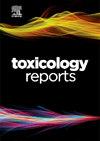Preventive treatment with guarana powder (Paullinia cupana) mitigates acute paracetamol-induced hepatotoxicity by modulating oxidative stress
Q1 Environmental Science
引用次数: 0
Abstract
Liver damage caused by high doses of paracetamol is a global public health concern. Consequently, therapeutic strategies are being explored to prevent this damage. The bioactive compounds present in fruits have shown promise in protecting against disorders associated with paracetamol-induced liver damage. This study assessed the preventive effects of guarana powder on redox status in a rat model of acute hepatotoxicity induced by a toxic dose of paracetamol. Male Wistar rats were divided into four groups: control (C), guarana (G), paracetamol (P), and guarana + paracetamol (GP). Animals in groups G and GP received 300 mg/kg guarana powder daily for seven days. Hepatotoxicity was induced in the P and GP groups by a single dose of 3 g/kg paracetamol on the last day. Paracetamol effectively induced liver damage and oxidative stress in group P animals. Preventive treatment with guarana significantly mitigated this damage and prevented the serum elevation of ALT, AST, and ALP by 44 %, 29 %, and 24 %, respectively. It also prevented a 133 % increase in the necrotic liver area in GP animals compared to the P. Guarana treatment, which prevented reductions in glutathione levels, modulated antioxidant enzyme (SOD and CAT) expression and activity, and protein carbonylation, while enhancing the total antioxidant capacity. Our results suggest that preventive treatment with guarana can attenuate oxidative damage, modulate antioxidant defense gene expression, and protect against paracetamol-induced hepatotoxicity in rats, highlighting guarana powder as a potential therapeutic agent to prevent liver damage induced by high doses of paracetamol.
预防性治疗用瓜拉那粉末(Paullinia cupana)减轻急性扑热息痛引起的肝毒性通过调节氧化应激
高剂量扑热息痛引起的肝损伤是一个全球性的公共卫生问题。因此,正在探索治疗策略以防止这种损害。水果中存在的生物活性化合物在预防扑热息痛引起的肝损伤方面显示出了希望。本研究评估了瓜拉那粉末对毒性剂量扑热息痛引起的急性肝毒性大鼠模型中氧化还原状态的预防作用。雄性Wistar大鼠分为4组:对照组(C)、瓜拉那(G)、扑热息痛(P)、瓜拉那+ 扑热息痛(GP)。G组和GP组每日给予300 mg/kg瓜拉那粉,连用7 d。P组和GP组在最后一天单次给药3 g/kg扑热息痛诱导肝毒性。对乙酰氨基酚可有效诱导P组动物肝脏损伤和氧化应激。用瓜拉那进行预防性治疗可显著减轻这种损伤,并分别防止血清中ALT、AST和ALP升高44. %、29. %和24. %。与P.瓜拉那治疗相比,它还阻止了GP动物坏死肝面积增加133 %,P.瓜拉那治疗阻止了谷胱甘肽水平的降低,调节了抗氧化酶(SOD和CAT)的表达和活性,以及蛋白质的碳酸化,同时增强了总抗氧化能力。我们的研究结果表明,用瓜拉那进行预防性治疗可以减轻氧化损伤,调节抗氧化防御基因表达,并保护大鼠免受扑热息痛引起的肝毒性,强调瓜拉那粉末是预防高剂量扑热息痛引起的肝损伤的潜在治疗药物。
本文章由计算机程序翻译,如有差异,请以英文原文为准。
求助全文
约1分钟内获得全文
求助全文
来源期刊

Toxicology Reports
Environmental Science-Health, Toxicology and Mutagenesis
CiteScore
7.60
自引率
0.00%
发文量
228
审稿时长
11 weeks
 求助内容:
求助内容: 应助结果提醒方式:
应助结果提醒方式:


